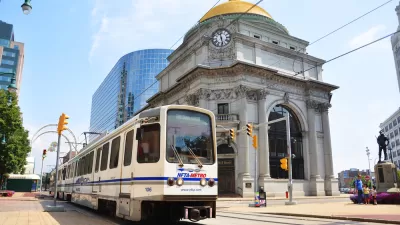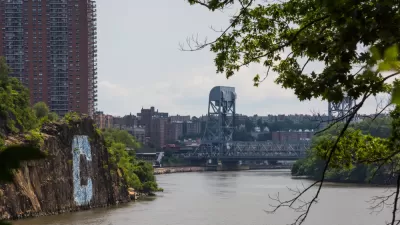A plan to revitalize Buffalo's Outer Harbor as an expansive, fully programmed park was sunk by a housing component. A new draft is expected soon.
Mark Sommer reports on the process of planning a new future for Buffalo's Outer Harbor. A previous planning process for the "526 acres of nature on a windy Lake Erie" culminated in September 2014 as a vision of pedestrian and bike paths, hiking trails, shoreline enhancements, boat launches, a gazebo, a playground, overlooks, and amphitheater, and a waterfront promenade, among other amenities and facilities.
But, Sommer reports, "adding housing and cultural development – the icing on the cake to some waterfront planners – proved to be a flash point. Opposition from the public and key lawmakers forced the plan back to the drawing board."
The proposal called for three clusters of housing, totaling between 1,500 and 2,100 units, which would help pay for the park that would make up most of the area. "But the idea of dense housing on the Outer Harbor scored poorly with the hundreds of people who participated in planning exercises," reports Sommer. "That included opposition to housing planned on land east of Times Beach, from where the Queen City Bike Ferry now arrives and departs, and Wilkeson Pointe. The waterfront agency said a study showed the preserve wouldn’t be harmed. Environmentalists disagreed."
The rest of the article goes on to examine other models that might influence the next draft of the plan, including the improvements made at the Milwaukee waterfront as well as standards set by the Green Code, expected for adoption by the Buffalo Common Council later this year.
FULL STORY: Outer Harbor popularity places spotlight on housing

Alabama: Trump Terminates Settlements for Black Communities Harmed By Raw Sewage
Trump deemed the landmark civil rights agreement “illegal DEI and environmental justice policy.”

Planetizen Federal Action Tracker
A weekly monitor of how Trump’s orders and actions are impacting planners and planning in America.

The 120 Year Old Tiny Home Villages That Sheltered San Francisco’s Earthquake Refugees
More than a century ago, San Francisco mobilized to house thousands of residents displaced by the 1906 earthquake. Could their strategy offer a model for the present?

In Both Crashes and Crime, Public Transportation is Far Safer than Driving
Contrary to popular assumptions, public transportation has far lower crash and crime rates than automobile travel. For safer communities, improve and encourage transit travel.

Report: Zoning Reforms Should Complement Nashville’s Ambitious Transit Plan
Without reform, restrictive zoning codes will limit the impact of the city’s planned transit expansion and could exclude some of the residents who depend on transit the most.

Judge Orders Release of Frozen IRA, IIJA Funding
The decision is a victory for environmental groups who charged that freezing funds for critical infrastructure and disaster response programs caused “real and irreparable harm” to communities.
Urban Design for Planners 1: Software Tools
This six-course series explores essential urban design concepts using open source software and equips planners with the tools they need to participate fully in the urban design process.
Planning for Universal Design
Learn the tools for implementing Universal Design in planning regulations.
Clanton & Associates, Inc.
Jessamine County Fiscal Court
Institute for Housing and Urban Development Studies (IHS)
City of Grandview
Harvard GSD Executive Education
Toledo-Lucas County Plan Commissions
Salt Lake City
NYU Wagner Graduate School of Public Service




























